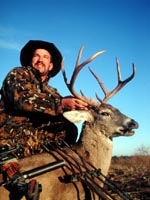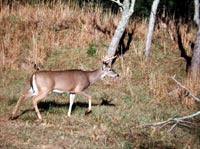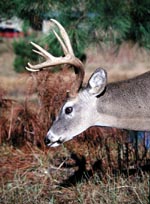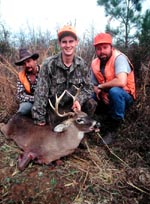
|
Features
|
|
|
|
Books
|
|
|
|
Fun & Games
|
|
|
|
Contact Us
|
|
|
John's Journal... Entry 125, Day 4
THE KING OF RATTLING
HOW TO RATTLE
 EDITOR'S
NOTE: You can use the rattling tactic to draw big bucks out of thick
cover anywhere in the nation. But just like any other deer-hunting tactic,
rattling won't always make a monster buck appear. Although many hunters
believe rattling works only on Texas ranches with their 1:1 buck/doe ratio,
you won't find this assumption true. But rattling appears to pay more
buck dividends in Texas and in other western states than it does in the
East. Generally you can see bucks coming to antlers from a greater distance
in the wide-open spaces of Texas than you can in the thick-cover areas
where most Easterners hunt. But I know you can bring bucks in to horns
anytime, anywhere you locate deer, whether early season, during the rut
or after the rut.
EDITOR'S
NOTE: You can use the rattling tactic to draw big bucks out of thick
cover anywhere in the nation. But just like any other deer-hunting tactic,
rattling won't always make a monster buck appear. Although many hunters
believe rattling works only on Texas ranches with their 1:1 buck/doe ratio,
you won't find this assumption true. But rattling appears to pay more
buck dividends in Texas and in other western states than it does in the
East. Generally you can see bucks coming to antlers from a greater distance
in the wide-open spaces of Texas than you can in the thick-cover areas
where most Easterners hunt. But I know you can bring bucks in to horns
anytime, anywhere you locate deer, whether early season, during the rut
or after the rut.
 Morvan
believes that you'll have the most effective rattling when a little breeze
stirs the air. "I like a 5- to a 10-mile-an-hour breeze, which makes
the antlers sound somewhat muffled through the wind. I always rattle in
to the wind to insure my scent is carried downwind of me. You always want
to position yourself downwind of where you think the deer may appear."
Although most magazine photos you see of rattling depict the buck moving
straight toward the hunter, real life doesn't always happen that way.
Regardless of which direction the buck comes from when you start rattling,
eventually he'll end up downwind of you. A buck usually circles downwind
of a fight to try to find out who's doing the fighting and if an estrous
doe is in the area.
Morvan
believes that you'll have the most effective rattling when a little breeze
stirs the air. "I like a 5- to a 10-mile-an-hour breeze, which makes
the antlers sound somewhat muffled through the wind. I always rattle in
to the wind to insure my scent is carried downwind of me. You always want
to position yourself downwind of where you think the deer may appear."
Although most magazine photos you see of rattling depict the buck moving
straight toward the hunter, real life doesn't always happen that way.
Regardless of which direction the buck comes from when you start rattling,
eventually he'll end up downwind of you. A buck usually circles downwind
of a fight to try to find out who's doing the fighting and if an estrous
doe is in the area.
When bucks hear antlers crashing, they hope to come in and pick up an estrous doe. Often a buck will circle downwind to determine whether an estrous doe is around or not. I believe he'll do that many times before he comes charging in to a fight. However, a dominant buck may run straight in to try to run off the other bucks. If the deer is a lesser buck, he may come to see the bucks in the herd fighting and weigh his chances of picking up an estrous doe. But no matter which way the buck moves in to see the fight, he more than likely will circle downwind. Most hunters take their bucks when the animals come out of thick cover and start to circle downwind. Usually they'll get more shots like that than they will at bucks charging straight in to them. However, if the buck picks up your scent downwind of you, you'll no longer play the game with him. He'll disappear.
 When
Morvan starts his rattling sequence, he doesn't clash the horns together
loudly as many other hunters do because, "I don't know how close
the deer is to me at that time." Morvan always assumes the buck will
be no more than 30 to 50 yards from him when he begins to rattle. He starts
off lightly and slightly clicks the horns together. "At the same
time that I click the antlers, I also blow lightly on a Quaker Boy Old
Buckster grunt call," Morvan says. "If a buck starts coming
in and sees me or begins to loop around me, I also use the grunt call
to stop him so I can get a shot." If Morvan doesn't see a deer, he
rattles louder and combines that tactic with pounding the butt end of
the antlers into the ground to simulate a buck's stomping. "If you've
ever watched bucks fight, you'll notice they'll clash antlers, stomp the
ground and grunt," Morvan reports. "I try to put that same type
of image in the mind of the deer when I rattle."
When
Morvan starts his rattling sequence, he doesn't clash the horns together
loudly as many other hunters do because, "I don't know how close
the deer is to me at that time." Morvan always assumes the buck will
be no more than 30 to 50 yards from him when he begins to rattle. He starts
off lightly and slightly clicks the horns together. "At the same
time that I click the antlers, I also blow lightly on a Quaker Boy Old
Buckster grunt call," Morvan says. "If a buck starts coming
in and sees me or begins to loop around me, I also use the grunt call
to stop him so I can get a shot." If Morvan doesn't see a deer, he
rattles louder and combines that tactic with pounding the butt end of
the antlers into the ground to simulate a buck's stomping. "If you've
ever watched bucks fight, you'll notice they'll clash antlers, stomp the
ground and grunt," Morvan reports. "I try to put that same type
of image in the mind of the deer when I rattle."
After this sequence, Morvan will wait about five minutes and then clash the antlers together hard, beat the ground with the butt of the antlers, rake limbs with the antlers and blow on his grunt call. "The very last thing I want to do is give all the sounds of a full-blown, big-buck fight," Morvan explains. "Often bucks will come busting out of the thickets when they hear that heavy rattling." If Morvan fails to bring in a buck to his rattling after 15 or 20 minutes, he'll move 1/4- to 1/2-miles away. Then he'll start his rattling sequence again. "My theory is if you're in thick cover, you need to rattle about every 1/4-mile," Morvan mentions. "You never know where a buck will be bedded down. I don't believe they can hear crashing antlers past 1/4-mile with a 5- to a 10-mile-per-hour wind blowing."
 On
Morvan's best day of rattling ever, he rattled in 14 deer for a hunter
out of one thicket where he had set up. Another time while hunting all
day, he rattled in 24 deer but had only two shooters out of 24. The hunter
with Morvan finally bagged an 8-point buck, 23 1/4-inches between the
main beams. "The other buck we didn't bag had 9 points and would
have scored in the mid-130s," Morvan said. "If you want to add
some spice to your deer hunting, try rattling."
On
Morvan's best day of rattling ever, he rattled in 14 deer for a hunter
out of one thicket where he had set up. Another time while hunting all
day, he rattled in 24 deer but had only two shooters out of 24. The hunter
with Morvan finally bagged an 8-point buck, 23 1/4-inches between the
main beams. "The other buck we didn't bag had 9 points and would
have scored in the mid-130s," Morvan said. "If you want to add
some spice to your deer hunting, try rattling."
To learn more about hunting big bucks, check out these
books from the Night Hawk Publication Library
"The
Masters' Secrets of Deer Hunting" and "How
to Take Monster Bucks."
TOMORROW: HOW TO USE WESTERN TACTICS IN THE EAST
Check back each day this week for more about the THE KING OF RATTLING...
Day 1 - The Ghost Buck
Day 2 - Why Rattle
Day 3 - Where To Set Up
Day 4 - How To Rattle
Day 5 - How To Use Western Tactics In The
East